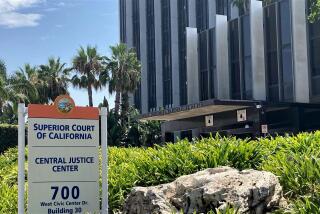RECOGNIZE SIGNS OF SEXUAL CHILD ABUSE OR MOLESTATION
- Share via
According to the Child Abuse Registry, there were more than 1,200 children sexually abused or in danger of being sexually mistreated in Orange County during the first two months of the year. That works out to almost one per hour.
Dr. Henry Giarretto is executive director of Parents United and AMAC (Adults Molested as Children), counseling/treatment groups that try to help victims and offenders. His concerns for children’s interests began with Parents United, which he formed in 1971 and which today has 160 branches nationwide.
The actual act of sexual molestation is not always “penetration,” Giarretto noted. It can include fondling, taking nude photographs and exhibitionism.
Children are often reluctant to report they have been abused. One rape in six occurs within the family, Giarretto estimates, and in one in 20 the rapist is a “father figure”--father, stepfather, male guardian. The embarrassment and shame deter girls and boys alike, and a child will often eventually accept the blame for tempting and provoking the abuser. Fear of disbelief, punishment and shame are also deterrents.
Teachers, school nurses, counselors, principals, supervisors of child welfare and attendance, other designated school personnel, child care providers and physicians are mandated by law to report known or suspected child abuse cases to the county Child Abuse Registry. But many reports come from nonprofessionals.
What should one look for?
Be observant of radical changes in a child’s behavior is Giarretto’s advice. A child’s excessive interest in things sexual or sexually aggressive behavior to other children would suggest a problem. “Kids do to others what they’ve learned,” said Giarretto.
Radical alterations in schoolwork over a short period of time--grades radically lower, or an active child who becomes very quiet and withdraws from other kids--would also suggest something is amiss.
The following signs may indicate something in addition to sexual abuse, but look for:
PHYSICAL SIGNS, which may include
Stained or torn underwear
Difficulty walking (especially if the child is young)
Discomfort in genital area (bruises, swelling, bleeding, etc.--so-called “insult to tissue”)
Frequent headaches or stomach aches
Pregnancy
Sexually transmitted disease
BEHAVIORAL SIGNS, which may include
Changes in behavior (mood swings, clinging or withdrawal, etc.)
Nightmares, bed-wetting or soiling
Acting out sexually or showing knowledge or interest in sex that is not appropriate for the child’s age
Loss of self-respect
General antisocial behavior, acting aggressively
Acting younger than actual age
Fears of certain places, people or activities
Poor schoolwork or frequent absences
Excessive compulsion about school, competence, anxiety about grades, wanting to excel
Shame about the body, extreme modesty
CHILDREN IN DANGER
In accounting for the number of children involved in abuse calls, the Orange County Child Abuse Registry includes not only children who are actually maltreated, but also the rest of the children in the family-that is, those in danger of being abused. During the first two months of the year, there were 5,439 such children in these reports, with sexual abuse accounting for about one-quarter. Here’s the breakdown by the different kinds of abuse.
Emotional: 3% Other: 3% Sexual: 23% Neglect: 27% Physical: 44% To report a case of child abuse, of any kind, call the Orange County Child Abuse Registry. The 24-hour number is (714) 834-5353. Social workers will answer the phone (during off hours--weekends and evenings--a counselor may answer), take down the child’s name and address and school if possible. A representative of the registry will try to see the child at school as a way to begin an investigation. If you are unsure, call the registry or tell your family doctor, who is required by law to report these allegations. For pamphlets, phone Children’s Services, (714) 937-2020.
The local chapter of Parents United, A Family Service Program is at 17421 Irvine Blvd., Tustin, (714) 838-7395. The organization offers treatment for the offenders, non-offending parents and the children.
More to Read
Sign up for Essential California
The most important California stories and recommendations in your inbox every morning.
You may occasionally receive promotional content from the Los Angeles Times.










